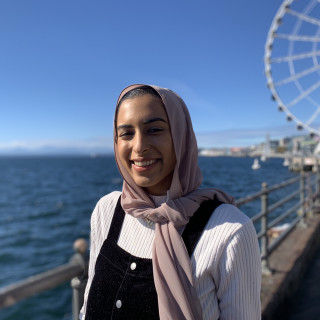You wouldn’t know from the way I dress for work most days that I am Muslim. In my scrub cap and face mask, I blend in with a sea of medical workers who cover themselves similarly to stymie the invisible threat of infectious transmission. If you glance at my hospital badge, only then do you see a smiling girl with a black scarf around her face, a message to those around me that covering my hair is not merely a medical precaution, but also a deeply personal religious choice.
The hijab, which means “barrier” in Arabic, is more colloquially used to refer to any form of head covering a Muslim woman wears because of her faith. Muslim women cover themselves in different ways. Some cover their bodies in addition to their hair (hijab) and mouth (niqab) or entire face (burqa). Some do not follow a particular dress code at all. While the material and construction may differ, the effect of PPE worn by health care providers, especially in the era of COVID-19, is similar, or even identical, to the ways Muslim women choose to cover themselves out of veneration of God.
As the world turns the corner on a year of battling a raging pandemic, donning PPE is largely seen in a positive light; masks, shields, hair coverings, and gowns are necessary measures taken to protect against infectious spread. PPE has become the symbol of one’s civic duty — as a health care worker or not — to save lives. Retailers have also capitalized on the ubiquitous nature of face coverings and made them fashion statements. Thus, just about everyone, including my own patients, can be seen with masks boasting intricate patterns or their favorite football team. This double standard is offensive to the many Muslim women who are discriminated against daily for covering their body (including or not including their face). The most blatant example of this hypocrisy is in France, where there is a mandate on wearing face masks, but a ban on wearing the niqab, an Islamic form of dress that entails covering all of one's body except the eyes.
Women who wear the hijab endure scarves being ripped off of their heads, being kicked out of establishments, taunts and death threats, unfriendly stares, and fervid glances. In 2017, at least 2,599 anti-Muslim incidents occurred across the country. Perceiving someone as Muslim and wearing a headscarf accounted for 27% of the triggers behind these incidents. Women who are visibly Muslim incur more discrimination than their non-veiled counterparts, and the more veiled one is (hair, mouth, entire face, etc.), the more unfavorably they are seen by those around them.
These sentiments percolate in the medical setting, where Islamophobic patients refuse to be taken care of by providers whom they know are Muslim, a facet of one’s identity made much more obvious by those who wear Islamic forms of dress. My experience with microaggressions has also been contingent on how I dress for work. On days when I have worn a scarf around my hair (as opposed to a scrub cap), my patients have asked me if I speak English, what country I am originally from, and if I am uncomfortably hot in my attire. On days when I am one of the masses wearing a scrub cap, mask, and perhaps more, I have never been subject to these questions. My hijab-wearing colleagues in medicine have also been met with resistance or outright rejection from patients because of the religious implications of their mode of dress, treatment they are largely spared from on days when they blend in with a scrub cap. This discrimination also extends to Muslim patients, who face blatantly disparate care from clinicians who can make assumptions about them based on their clothing. Such traumatic experiences even contribute to Muslim women’s hesistancy to seek medical care, which deepens health disparities among this population.
The inability for society to accept face coverings, and other more conservative modes of dress worn by Muslim women, while approving the use of face masks out of function or fashion is outrightly discriminatory and oppressive to the Muslim identity. It is clear that dislike or fear of Muslim female attire does not stem from disapproval of face or hair coverings in general, which are worn by countless people for a host of reasons (medical attire, sports attire, weather attire, fashion, etc.). Rather, it is Muslim face coverings in particular that garner discriminatory treatment because of their association with Islam, presently one of the most persecuted religions in the U.S.
Reverence for a higher power calls on Muslim women to cover. Preventing infectious spread of disease calls on many of us to wear PPE. The asymmetrical perceptions and treatment of these two groups of people are a hypocritical blow to Muslim women like me who must brave societal’s frank prejudice against us and how we dress every minute of our existence. The way I am treated should not be determined by the appearance of my head covering or the perceived motives regarding my reasons to cover, medical or not. Regardless of these factors, I am equally human, equally physician, and equally capable to serve.
What ways do you help fight discrimination for your Muslim health care workers and patients? Share in the comments.
Sara is a Los Angeles native in her first year of pediatrics training at Seattle Children's Hospital in Seattle, WA. She enjoys reading, hiking, taco trucks, chai, and her cat, Tibby. She is a 2020–2021 Doximity Op-Med Fellow.
Illustration collage by April Brust







